In my June description of the recent AMIS meeting in Vermillion, South Dakota, I mentioned the new discoveries I made in the very first morning session: “The Finds of a Curio-Hunter: Frederick Stearns and His Collection” – presented by previous collection curator Chris Dempsey.
I’ve since done some follow-on research and am ready to report!
Briefly, the Stearns Collection came about when the wealthy Michigan pharmaceutical businessman Frederick Stearns spent his retirement years traveling the world and collecting rare and unusual objects, including musical instruments. He donated the collection to the University in Ann Arbor in 1899 and then continued to add to it until his death in 1907. The collection was cataloged (here are the 1918 and 1921 editions) and displayed for decades, but finally put into storage in 1974. Today it remains mostly in storage, despite a small staff and public donations. My takeaway from the paper by its past curator is that, bluntly put, the current University management has no interest in it.
That’s the bad news. The good news is that Chris took photographs of the collection a dozen years ago and in 2011 the collection went up digitally (though the images are unnecessarily small). Using these images, the catalog information, and some scans of unpublished plates I got from Chris, I’ve been able to make some educated guesses about what follows.
More bad news: In the three grouped instrument plates shown here, each contains an unknown amount of questionable forgeries or altered historical specimens by the notorious dealer and hack luthier Leopoldo Franciolini. Unfortunately, Stearns appears to have been one of his favorite dupes. Thankfully, the majority of instruments Stearns acquired are genuine. The fascinating if aggravating character Franciolini (nutshell version here) continues to lead scholars a merry chase! While the endless harpsichord and other more popular instrument frauds have been largely unmasked – as well as 38 specific suspect instruments in the Stearns Collection – I spot at least one other, explored below. After looking at some of these unusual instruments, I suspect there may be many more. If it looks like a rare and intriguing “one-off,” odds are it’s a Franciolini chimera. What a treasure hunt!
Upon asking Chris for a copy of the slide he showed in his AMIS paper (above), he let me look through his file folder and I found a couple other interesting ones. Actually, all were interesting – these are plates created in the 1899-1902 time frame and intended for the original catalog of the collection. For some reason, when the catalog was finally put out in 1918, completely different images were used (and not for the better, though it’s interesting to see the old chock-full display cases). Though we have images of the instruments circa 2000, these never-published plates show them soon after they were acquired and remain of great historical interest.

Plate 85 contains both traditional instruments and mystery instruments. The lyre guitar with the unusual soundholes (a diamond and two S-holes) is labeled “Q. Marin” according to the catalog but “Andrés Martin, Valencia, Spain” according to the site (#1121). Curiously, it is a double course guitar; as I recall, this was an early transitional Spanish form as Baroque guitars gradually evolved from five double courses to six single strings. I hadn’t seen it on a lyre guitar before, and am curious if it has any significance. Of course I was intrigued by the lyre mandolin that looks like it was stunted in childhood. Said to be of “very poor quality,” it was made in Naples, Italy by Luigi Sartosio (#1072).

Plate 87 was full of similarly intriguing instruments but caught my eye for obvious reasons – the Schenk-style harp guitar, which does not match any previously known maker’s. I’ll discuss that one also next. Note also the “Fabricatore” lyre guitar, with its unusual “horseshoe crab” body. We’ll be using it for comparison later as well.

For me, the real prize that Chris Dempsey shared from the under-researched Stearns files was this beautiful 1896 photograph.
It shows a remarkable, previously unknown instrument – what was probably named a “guitarpa,” the go-to portmanteau name for combination “guitar and harp” inventions throughout history (bonus: it works in almost every language!). In this case, it’s a standard six-string guitar with a soundboard and box that extend to the floor. Another one to add to my growing Harp Guitar Definition Appendix.
Note how this photo was originally planned to be inserted into the catalog as well, cropped with paper – fortunately not covering any critical details – with instructions to “reduce to 2 x 3-1/2 inches.”

The details are written on the back, in at least three different hands. Whose hand remains unknown (though Chris believes Stearns’ is the predominant).
Deciphering the name of the young woman was the most difficult – Maria Elena Fourroge is our best guess, but her surname isn’t found anywhere online, in any language. At the top, her name was written by Scribe 1. The same person, or Scribe 2, added “5-6-96” – perhaps the date of the photo session?
Next, Scribe 3 (Stearns?) writes the description: “Guitar-harp – invented in 1895 at Buenos Ayres, Argentina by Francisco Correa Llobet, Medical student, for the young lady whose portrait is shown hereon playing, Miss Maria Elena Fourroge, his affianced bride. Gift of Dr. Estanislao S. Zeballos Aug 14, 1896.”
Finally, the phonetic spelling of “(gee-tar-pah)” was penciled in later by a Scribe 4 – perhaps a curator who decided or learned that it was the invention’s proper name.
The name of the obviously capable luthier Llobet does not show up anywhere; he remains a complete mystery, beyond the fact that he was a medical student who likely studied under Dr. Zeballos.
Zeballos was fairly easy to find information on – he was a doctor, lawyer, scientist, writer, and held numerous diplomatic positions in South America, including Minister of Foreign Affairs for Argentina. My wife (who helped me decipher the writing and install the implied punctuation above) believes the “gift” may have been Zeballos funding the construction project. I counter with it to mean the gift of the professional photograph taken of the fiancé or the gift could have been Zeballos simply giving the photo to Stearns. Regardless, none of this seems to reconcile or help decipher the May 6 and August 14 dates.
It’s a wonderful instrument and image nonetheless – if only we knew the whole story!
Returning now to the plates above, the most important find may be this one. Though the new color images are tiny, we’re lucky to have the original black and white plate. I couldn’t imagine who might have built this and when – as it came from Stearns’ 1901 collecting trip! I was thrilled to see that it had a label, and quickly looked up #1132 in the Stearns catalog.
Interesting! The catalog gives “Signed ‘Pietro Messori, Modena’,” while the site clarifies with “Pietro MESSORI, Modena, fatto l’anno 1899.”
Messori (1870–1952) was a violin maker in Modena, Italy. The sole scant information comes from John Dilworth (who offered no further information or comments on the harp guitar). He lists Messori as “Pupil of Giuseppe Sgarbi from 1893. Worked for Fiorini in Munich before returning to Modena. Awarded many medals and honours in Milan, Paris, Turin, St Louis (USA), and Geneva. Stradivari, Guarneri, and Amati models.”
This would suggest that Messori built the harp guitar after seven years of apprenticeship (unless he had studied previously) – something violin expert Alberto Giordano finds surprising “since he was still an apprentice in violinmaking while the guitar is professionally made.” Not being a violinmaker, I can’t speak to that skill set or if this indeed an anomaly.
Unfortunately, I am as yet unable to learn the dates of Messori’s stint in Munich – for surely that could have been where he came across one of Schenk’s original instruments (or a copy) – perhaps even the same instruments Luigi Mozzani would also see! Either way, it seems that a little-known violin apprentice beat Mozzani to the Italian version of these Schenk dual arm harp guitars by a good decade! Unlike Mozzani, who would revamp the headstock for standard tuner placement on his floating neck, Messori copied Schenk’s design very closely, including the soundhole design, then created his own stylized bridge. He increased the typical three sub-basses to four, while reducing Schenk’s 24 frets to 23.
Modena is less than 30 miles from Bologna, where Mozzani was then based, having started building after 1900. Could the maestro have known of Messori’s instrument?!

We come now to Plate 86 (shown at the top of the article), the original image Chris showed at the AMIS meeting that jolted me out of my seat on that very first morning. It includes a very distinctive hollow arm harp guitar that Stearns acquired on his 1901 European collecting trip.
“What?!” “Where?!” and “Who?!” was my immediate reaction. It doesn’t resemble any design or maker’s style I’ve ever encountered. Pre-1900 Italian? French? English? The catalog states:
“1124: Harp-Guitar, Italy. In its general outline the body resembles the harp, hence its name. Nineteen frets. Five strings on finger-board (there are six – GM) and seven of over-spun silk. Length, 95 cm. Width, 41.5 cm. Depth, 9 cm. (37+ x 16+ x 3-1/2”).”

It was when I got home and started looking into this one that I recalled Chris mentioned in his talk something about Franciolini (described above). I wasn’t that familiar with this nefarious character so began looking into him – what he did, could do, and how Stearns was a particularly gullible mark. It occurred to me that “Franciolini” might be Italian for “Frankenstein” (I don’t want to look it up and spoil my gag) – for this mad doctor/luthier specialized in creating literal “Frankenstein’s monsters” by combining bits of instruments, or antique instruments with new (typically poor) workmanship, relabeling, what have you.
That’s what I think we’re looking at here: a Franciolini creation. 1) Nothing like it exists elsewhere, 2) It’s overly gaudy, 3) The catalog’s inclusion of “Italy” as the country of origin could certainly implicate Franciolini as the source, 4) The edge decoration is extremely similar in style and workmanship to the “Fabricatore” lyre guitar (below), acquired from Franciolini, and with the Stearns site lists among its “suspect Franciolini instruments.” While that instrument closely resembles a very similar instrument in the Brussels museum, the obviously crude decoration does not.
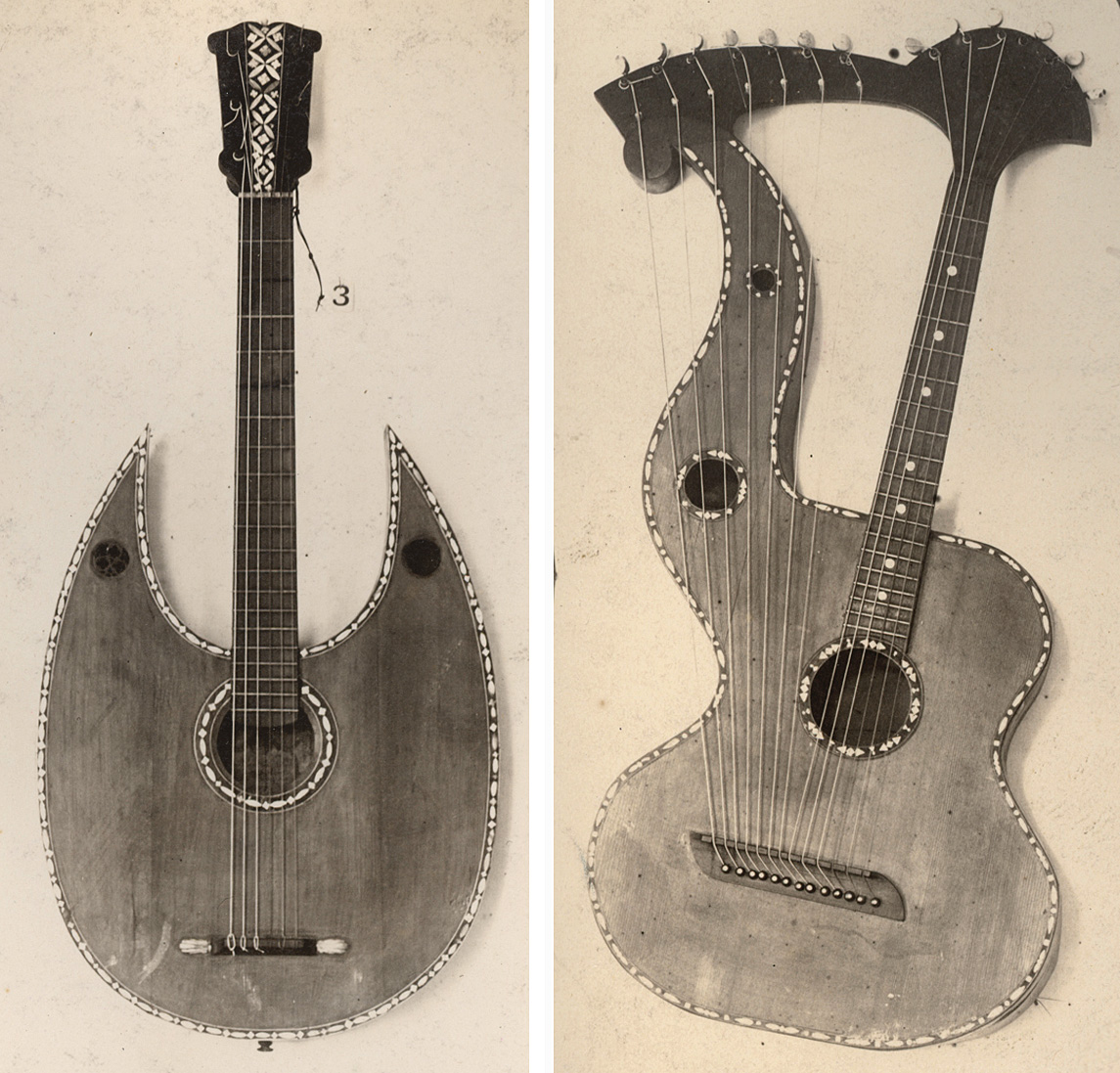
Finally, learning that there was a rare book published on Franciolini’s catalogs, I knew I should exhaust that avenue (oh, for a smoking gun!). Passing on the sole $500 copy at Amazon, I found it up the street at CSUN, where the bored but helpful college kids behind the main counter snuck it out from under lock & key in Stored Books and I was able to peruse (and iPhone shoot) it. Alas, I couldn’t find the harp guitar in any lists (the c.1900 catalog might have had it on this page), nor the c.1895 catalog pages – which just means it was one of the many additional instruments we know Franciolini offered. I did find the “Fabricatore” lyre guitar (with the same “wrong” date Stearns lists) and the zither shown in Plate 85 above, along with similar made-up stringed instruments in every size and shape, similar to some of the Stearns’.


Back to the mystery harp guitar – none of this helps to answer our key questions: Was this a real instrument before Franciolini altered it? Whose? Built when? And if not – if only his own “one-off” creation he made from scratch, what could he possibly have based it on? Because it predates most if not all hollow arm Italian harp guitars! Those – other than the new dual arm Messori discovery above (please don’t tell me that also came from Franciolini!) – were just being “invented” about 1900, most a decade or two later, and none near Franciolini in Florence. It’s maddening! (Note that this one already looks worn, which means nothing since he also “aged” instruments to fool his clients.)
I actually quite like the design; it sort of resembles a Form 3a hollow-arm harp guitar (Knutsen, Gazzo, Mozzani, etc.) crossed with a Form 5 “harp frame” type, all of which have a post rather than the arm.
Note the severe angle of the strings from the bridge’s guide slots to their pins. Was this an attempt to better center the bridge and its soundboard-weakening pin holes? If so, it shows a lot of ingenuity!

Stearns managed to collect several other harp guitars of different form and varying quality.

I knew of the wonderful (if in serious need of a cleaning) Lacote decacorde previously only from a black and white photo in the Baines book; now we have color images to add to the Lacote archive.

#1125 is unlabelled, attributed to England (perhaps where it was acquired); it shows a distinctive configuration of the necks and headstock, and it’s true origin remains unknown (German?).

This unfortunate harp guitar (#1120) with what looks like an “over-application of lipstick” had me excited as it is labeled “Orlandi Sebastino, Fabbricante di Chitarre in Genoa, 1868.” A Genovese harp guitar of that era would be an interesting find, indeed. However, the site states that it appears to have been a 6-string guitar (descended from the Guadagnini, perhaps) that had the extension added. That might explain the mess around the replaced bridge as well.

#1126 above is another possible Francolini-modified harp guitar, according to the Stearns site. They point out differences in quality of its neck and body, with indications from the neck block that it may have had a 6-string neck. All I know is that the square fretboard end looks totally bogus.

In the “relatives” department, this is an interesting arch-cittern of some sort purportedly from Germany (#1128). I’d never heard the term “bijuga-cither” before, but see that this was once used for “double” citterns. Unusual for a cittern, it has just five single strings on the neck, with eight floating basses, for which an absolutely amazing capotasto mechicsm is attached. I thought this was similar to those found on Swedish lutes of the early 1800’s, but it is an ingenious rotatable wheel with six positions: each has a specifically cut nut of bone/ivory inserted in the frame, a “partial capo” that frets the eight basses for six different keys!
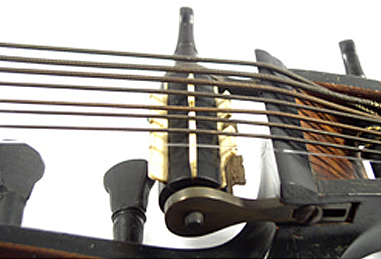
With its strings running to the tail block, it was undoubtedly strung with steel, yet the five single neck strings is curious. The Stearns site has now labeled it with the optional names of “theorbo guitar” and “arch-cittern-guitar” – perhaps it is some sort of hybrid of arch-cittern and 5-course guitar?
And lastly, another look at a favorite I blogged about long ago – yes, it’s the Snail-Dragon Thingy!
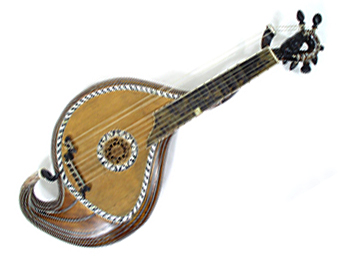

Looking at these new photos, I see that this one does indeed resemble an engorged serpent (though my python at his greediest never looked like this!) – ergo their name of “Serpent Guitar.” It is actually a harp guitar, with its two floating basses (assuming the six neck strings were meant to have guitar tuning). You can see the sinuous neck curving around to hold the tuners, open mouthed. What a fascinating creation – especially knowing that it’s not a one-off – three are known, two of which are virtually identical. And still its origin remains a mystery.
As does the future of the Stearns Collection…



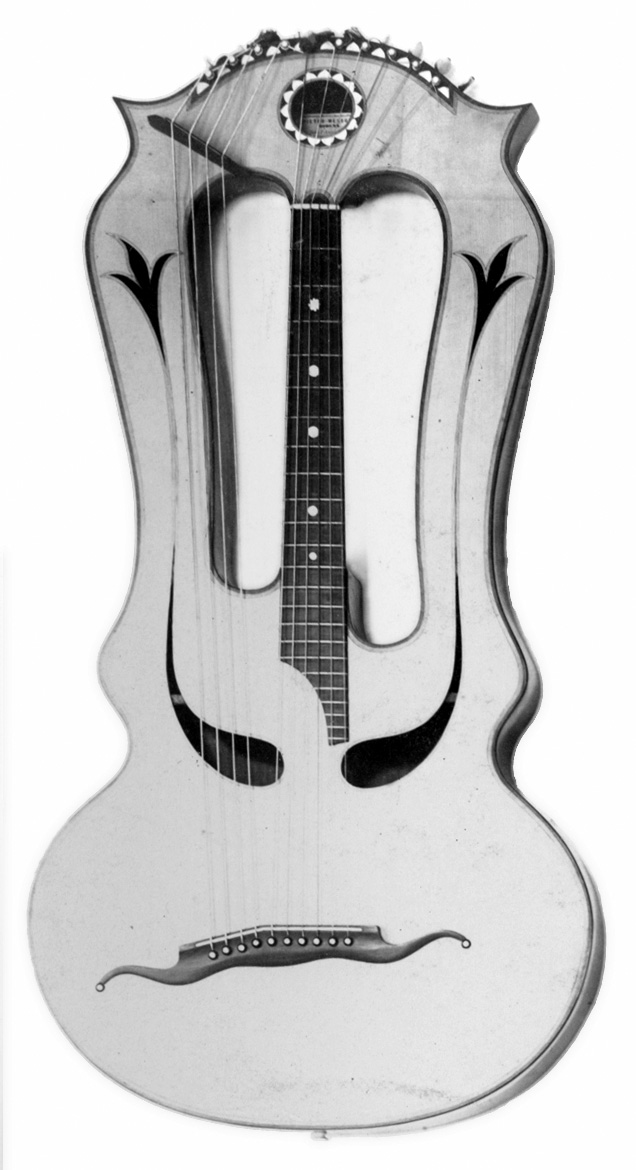



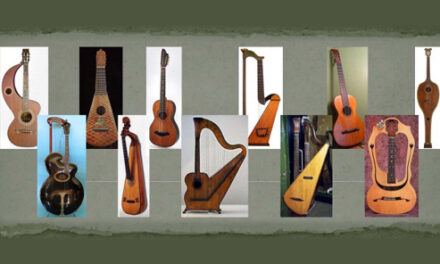

Hey Gregg, I love the mechanism on #1128. That would be the kind of crazy thing that I would do if I was a luthier.
Me too, Steve. That’s just another reason why I make an effort to share all this old forgotten stuff – you never know what may spark a new brainstorm!